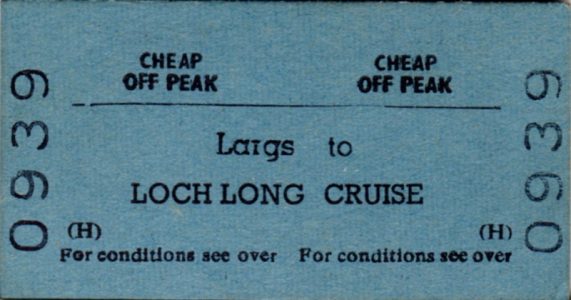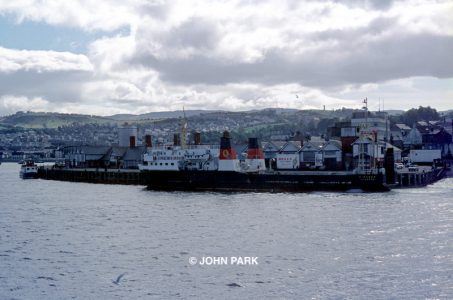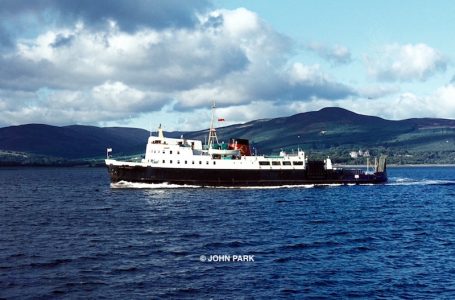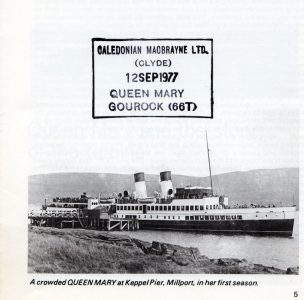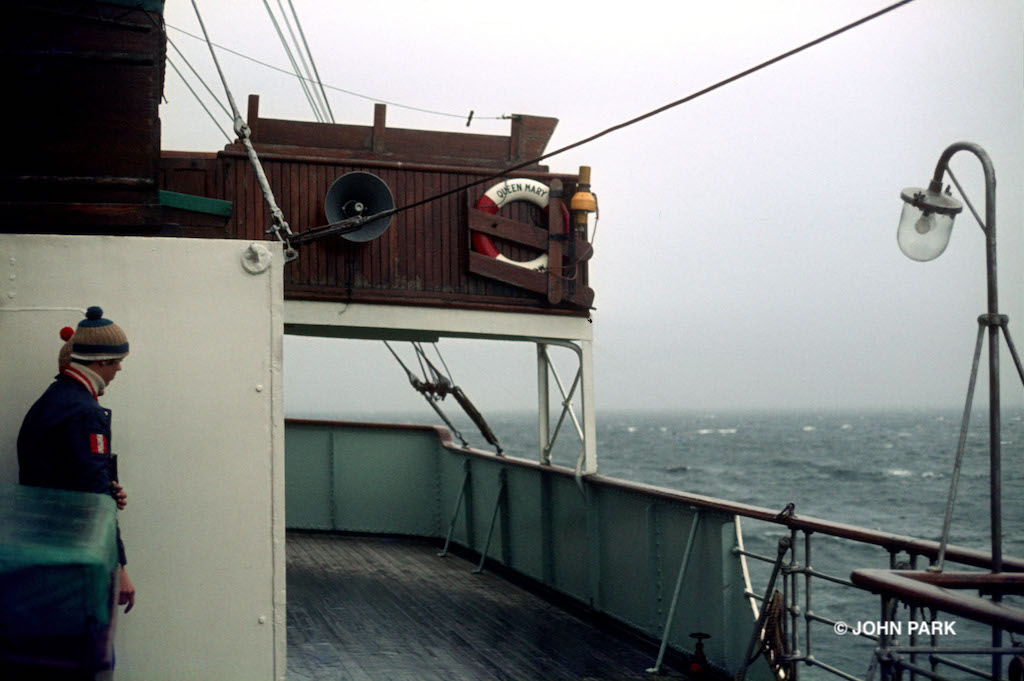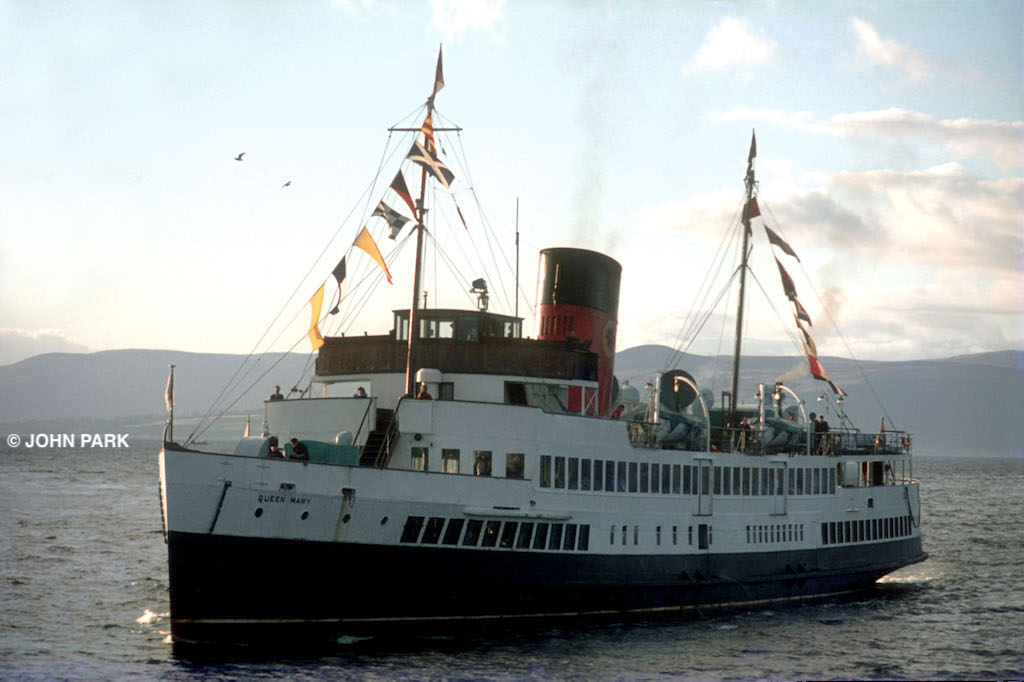
End of an era: Queen Mary arriving at Dunoon on 12 September 1977, her last day of service on the Clyde
John Park was on board Queen Mary in September 1977 for her final day in service as a Clyde excursion steamer. More than 40 years later, he remembers it as ‘a genuine end-of-an-era occasion’.
Although there had not been any official announcement, the expectation in Club circles was that 1977 would be the last year of Queen Mary. Many of us had expected such an announcement at the end of her 1976 season, so her reappearance the following summer felt like something of a bonus.
The final sailing of her 1977 season was originally intended to be a cruise on Sunday 11 September from Gourock to Campbeltown, a fitting destination if it was likely to be the end of turbine steamer operation on the Clyde.
However, it was announced quite late that the ‘Mary’ would perform additional end of season cruises on Monday 12 September. These were to be an afternoon cruise from Largs, Rothesay and Dunoon to Loch Goil and Carrick Castle, followed by an evening Showboat cruise from Largs and Rothesay, thus bringing her season to a close.
It proved to be a rather fortunate change as things turned out. The Sunday cruise, a CRSC nominated excursion, was a miserable wet and windy affair which got as far as Brodick before the weather forced a change to the itinerary, denying everyone aboard that final historic turbine visit to Campbeltown.
In complete contrast, Monday 12th was bright and sunny, with only a light breeze for what turned out to be her last day in service. And while the weather would not present any problems on this day, trying to get time off work on a weekday must have proved difficult for many.
I had spent most weekends that summer chasing after the ‘Mary’, either sailing on her or just photographing her at various locations, so I was absolutely not going to miss out on her very last sailing. Fortunately I had an understanding boss, so I managed to escape work at lunchtime and caught a train to Gourock in time for the advertised 1345 connection to Dunoon, where I would join the cruise.
I boarded one of the ‘streakers’ at Gourock, and she had no sooner cleared the linkspan when a quite unexpected bonus came into view. Pioneer had just that moment arrived at the head of the pier from Port Ellen, having made her way to the Clyde that morning to have a recurring bow thruster fault repaired at Govan.
I was quick enough with my camera to capture this rare call as I passed by on the ‘streaker’, and then watched from a distance as Pioneer left again shortly afterwards to make her way upriver to Govan.
Arriving at Dunoon 20 minutes later, I soon spotted the familiar profile of Queen Mary as she rounded Toward Point and made her way up-firth along the Cowal coast. This was a most colourful panorama, with her fine bow cutting through the sparkling blue waters of the Firth. It was one of those moments to savour before finding a position for photographs.
There was a reasonable number aboard when she departed Dunoon at 1435. Her top deck had a busy look as passengers took advantage of the sunny conditions, although there were only a few familiar faces among the crowd. Loch Long and Loch Goil were as picturesque as ever, but the non-landing nature of the cruise meant there were only limited opportunities for photographs during the afternoon.
During this lull in camera action I set about acquiring a souvenir which would be unique to this last day. I purchased a copy of the Queen Mary booklet by Richard Orr which was available to buy on board that summer. Next was a visit to the Purser’s Office to have an inside page stamped and dated with the ship’s stamp. I still have the booklet to this day.
On the return passage between Loch Long and Dunoon a small light aircraft began to circle overhead and made a couple of quite low passes — somebody up there was clearly taking quite an interest in the ‘Mary’.
I did briefly wonder where the late great Jim Aikman Smith might be that afternoon, but taking to the air for one of his legendary exclusives had never been Jim’s way. The mystery of the aircraft would be solved later that day.
Queen Mary arrived back at Dunoon shortly after this excitement, but I was going to remain on board for the rest of the day. She bid Dunoon farewell for the last time shortly after 1630, and then retraced her steps back along the Cowal coast to make the return call at Rothesay. We had not long left Dunoon when Glen Sannox appeared in the distance.
She had departed Wemyss Bay at 1645 and was also heading for Rothesay. We met the ‘Sannox’ just as we rounded Toward point, and for a short while these two favourites steamed towards Rothesay together on parallel courses.
The turbine gradually pulled ahead and then followed a course towards the Craigmore shoreline before arriving at Berth No. 3. Glen Sannox arrived at the car ferry berth shortly after and berthed bow to bow with the ‘Mary’. I remember there was some humorous banter and gesturing between the two sets of rope handlers about what had taken the ‘Sannox’ so long to arrive.
The ‘Mary’ left Rothesay again at 1720 and made her way back across the Firth to Largs, where the afternoon cruise ended shortly after 1800.
All passengers had to disembark, including those of us planning to join the evening Showboat cruise. The crew had to prepare the ship and get “Jimmy Blue and his Scottish Country Dance Band” set up in the shelter deck saloon, ready to provide the evening’s entertainment.
Largs was quite busy on what was a pleasant late summer evening, with people mingling on the seafront and small leisure boats pottering about in the bay.
Waverley added to this busy scene when she arrived towards the end of her Monday cruise to land passengers returning to Largs and Glasgow (by coach). The turbine had to vacate the pier for this to happen, so she circled round to lie out in the bay while the paddler landed her passengers. Waverley departed for Ayr a short time later, allowing the ‘Mary’ to return to the pier: she was now looking quite resplendent dressed overall for her Showboat cruise.
Tickets for this cruise could only be purchased from the ticket office on the pier prior to boarding and had to be surrendered again at the gangway as we boarded, so there would be no final cruise ticket to add to my collection. I had at least managed to retain my ticket from the afternoon cruise.
Queen Mary left Largs on her Showboat cruise at 1900 and set a course across the Firth towards Rothesay and the setting sun. The publicity material for the cruise did not give any destination, but upon leaving Rothesay it became obvious the turbine was to have one last visit to the Kyles of Bute.
I don’t recall her being especially busy that evening, but there was a good lively atmosphere on board as she headed towards the Narrows with darkness descending over the Kyles.
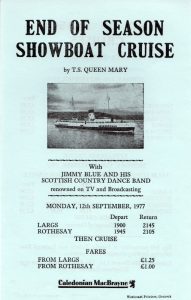
CalMac cruise leaflet for the final service sailing of Queen Mary — using a standard publicity shot from CSP days, with a lion poorly faked onto the funnel
In what seemed like no time at all the ‘Mary’ had passed through the Narrows, turned somewhere near the entrance to Loch Riddon, and was now heading back along the east Kyle towards Rothesay. It had become quite chilly up top, so I went below for a while to sample the entertainment and enjoy the jovial atmosphere in the saloon area.
I returned upstairs to the fresh air as we approached Rothesay from the west and eased into Berth No. 1. A long and rather poignant announcement over the public address system acknowledged that this was in all probability her last public sailing, and at just after 2100 she bade Rothesay a final farewell with a series of long blasts on her whistle, as she swept away from the pier for the last time. It was a real lump-in-the-throat moment.
The last leg back to Largs passed very quickly. There seemed to be hardly any time from the distant twinkling lights of Largs coming into view, to them suddenly being close enough to pick out the navigation lights on the pier.
The telegraphs soon began to ring out their melodic clangs as we approached, and the public address system repeated the sentimental farewell message of earlier. We gently came alongside at around 2145.
Suddenly it was all over and I was standing on the pier chatting with a few other Club members. The cruise had ended. The day had ended. Queen Mary had almost certainly reached the end of her life as a cruise steamer. It was another of those genuine ‘end of an era’ occasions.
Arriving home late, I learned that Queen Mary’s last day had made the Scottish news on television that evening and there had been some great aerial footage. That explained the attentions of the light aircraft during the afternoon. Writing this piece more than 40 years later, I wonder if that footage survives in the archives of BBC Scotland or STV.
Queen Mary returned light to Gourock that evening. The following day she left Gourock at 1225 and made the final journey under her own steam to East India Harbour at Greenock. An announcement two months later, on 17 November, confirmed that Glen Sannox would replace the ‘Mary’ for the 1978 season.
It was the end of her career as a Clyde steamer but not the end of her story. Further chapters were to follow, including a long Thames sojourn and a return to the Clyde in May 2016 for static preservation.
All images on the CRSC website are protected by copyright law. Do not reproduce them on Facebook, Pinterest or any other public platform.

‘She was now looking quite resplendent dressed overall for her evening Showboat cruise’: Queen Mary off Largs on 12 September 1977
How about joining CRSC? You can do so for just £10 by clicking here — and you’ll receive all the benefits, including our annual Review of west coast ship movements, a 56-page colour magazine, discounts on photo offers and access to photo-rich ‘members only’ posts.
MORE FROM JOHN PARK
Postcards from Stornoway (2020)
Battling a southerly swell in Millport Bay (2020)
King George V’s last public cruise (2020)
Postcards from the Uig triangle (2020)
●
Published on 3 February 2021












